Related Research Articles

The Local Group is the galaxy group that includes the Milky Way. It has a total diameter of roughly 3 megaparsecs (9.8 Mly), and a total mass of the order of 2×1012 solar masses (4.0×1042 kg). It consists of two clusters of galaxies in a "dumbbell" shape: the Milky Way and its satellites form one lobe, and the Andromeda Galaxy and its satellites constitute the other. The two clusters are separated by about 0.8 Mpc (2.5×1022 m) and move towards one another with a velocity of 123 km/s. The group itself is a part of the larger Virgo Supercluster, which may be a part of the Laniakea Supercluster. The total number of galaxies in the Local Group is unknown as some are occluded by the Milky Way; however, at least 80 such objects are known (most of which are dwarf galaxies).

The Large Magellanic Cloud (LMC) is a satellite galaxy of the Milky Way. At a distance of around 50 kiloparsecs (≈163,000 light-years), the LMC is the second- or third-closest galaxy to the Milky Way, after the Sagittarius Dwarf Spheroidal (~16 kpc) and the possible dwarf irregular galaxy known as the Canis Major Overdensity. Based on readily visible stars and a mass of approximately 10 billion solar masses, the diameter of the LMC is about 14,000 light-years (4.3 kpc), making it roughly one one-hundredth as massive as the Milky Way. This makes the LMC the fourth-largest galaxy in the Local Group, after the Andromeda Galaxy (M31), the Milky Way, and the Triangulum Galaxy (M33).
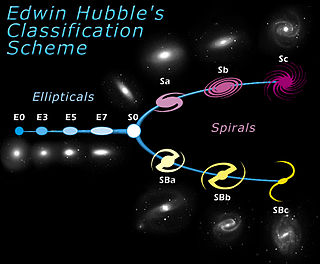
The Hubble sequence is a morphological classification scheme for galaxies invented by Edwin Hubble in 1926. It is often colloquially known as the Hubble tuning fork diagram because the shape in which it is traditionally represented resembles a tuning fork. In June 2019, however, citizen scientists through Galaxy Zoo reported that the usual Hubble classification, particularly concerning spiral galaxies, may not be supported, and may need updating.

The Magellanic Clouds are two irregular dwarf galaxies visible in the Southern Celestial Hemisphere; they are members of the Local Group and are orbiting the Milky Way galaxy. Because both show signs of a bar structure, they are often reclassified as Magellanic spiral galaxies. The two galaxies are:

The Small Magellanic Cloud (SMC), or Nubecula Minor, is a dwarf galaxy near the Milky Way. Classified as a dwarf irregular galaxy, the SMC has a diameter of about 7,000 light-years, contains several hundred million stars, and has a total mass of approximately 7 billion solar masses. The SMC contains a central bar structure, and astronomers speculate that it was once a barred spiral galaxy that was disrupted by the Milky Way to become somewhat irregular. At a distance of about 200,000 light-years, the SMC is among the nearest intergalactic neighbors of the Milky Way and is one of the most distant objects visible to the naked eye.

Spiral galaxies form a class of galaxy originally described by Edwin Hubble in his 1936 work The Realm of the Nebulae and, as such, form part of the Hubble sequence. Most spiral galaxies consist of a flat, rotating disk containing stars, gas and dust, and a central concentration of stars known as the bulge. These are often surrounded by a much fainter halo of stars, many of which reside in globular clusters.
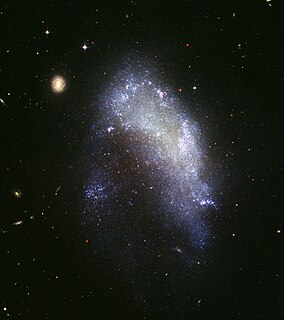
An irregular galaxy is a galaxy that does not have a distinct regular shape, unlike a spiral or an elliptical galaxy. Irregular galaxies do not fall into any of the regular classes of the Hubble sequence, and they are often chaotic in appearance, with neither a nuclear bulge nor any trace of spiral arm structure.

Galaxy morphological classification is a system used by astronomers to divide galaxies into groups based on their visual appearance. There are several schemes in use by which galaxies can be classified according to their morphologies, the most famous being the Hubble sequence, devised by Edwin Hubble and later expanded by Gérard de Vaucouleurs and Allan Sandage. However, galaxy classification and morphology are now largely done using computational methods and physical morphology.

A barred spiral galaxy is a spiral galaxy with a central bar-shaped structure composed of stars. Bars are found in about half of all spiral galaxies. Bars generally affect both the motions of stars and interstellar gas within spiral galaxies and can affect spiral arms as well. The Milky Way Galaxy, where the Solar System is located, is classified as a barred spiral galaxy.

A dwarf galaxy is a small galaxy composed of about 1000 up to several billion stars, as compared to the Milky Way's 200–400 billion stars. The Large Magellanic Cloud, which closely orbits the Milky Way and contains over 30 billion stars, is sometimes classified as a dwarf galaxy; others consider it a full-fledged galaxy. Dwarf galaxies' formation and activity are thought to be heavily influenced by interactions with larger galaxies. Astronomers identify numerous types of dwarf galaxies, based on their shape and composition.
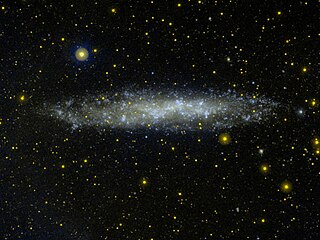
NGC 3109 is a small barred Magellanic type spiral or irregular galaxy around 4.34 Mly away in the direction of the constellation of Hydra. NGC 3109 is believed to be tidally interacting with the dwarf elliptical galaxy Antlia Dwarf. It was discovered by John Herschel on March 24, 1835 while he was in what is now South Africa.

The NGC 1569 is a dwarf irregular galaxy in Camelopardalis. The galaxy is relatively nearby. Consequently, the Hubble Space Telescope can easily resolve the stars within the galaxy. The distance to the galaxy was previously believed to be only 2.4 Mpc. However, in 2008 scientists studying images from Hubble calculated the galaxy's distance at nearly 11 million light-years away, about 4 million light-years farther than previous thought, meaning it is a member of the IC 342 group of galaxies.
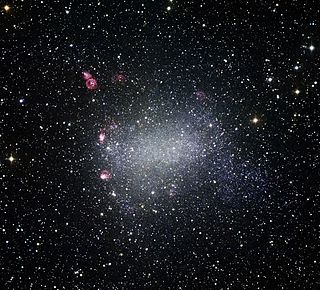
NGC 6822 is a barred irregular galaxy approximately 1.6 million light-years away in the constellation Sagittarius. Part of the Local Group of galaxies, it was discovered by E. E. Barnard in 1884, with a six-inch refractor telescope. It is one of the closer galaxies to the Milky Way. It is similar in structure and composition to the Small Magellanic Cloud. It is about 7,000 light-years in diameter.

Interacting galaxies are galaxies whose gravitational fields result in a disturbance of one another. An example of a minor interaction is a satellite galaxy disturbing the primary galaxy's spiral arms. An example of a major interaction is a galactic collision, which may lead to a galaxy merger.

NGC 4618 is a distorted barred dwarf galaxy in the constellation Canes Venatici. The galaxy is formally classified as a Sm galaxy, which means that its structure vaguely resembles the structure of spiral galaxies. The galaxy is sometimes referred to as a Magellanic spiral because of its resemblance to the Magellanic clouds.
Magellanic spiral galaxies are (usually) dwarf galaxies which are classified as the type Sm. They are galaxies with one single spiral arm, and are named after their prototype, the Large Magellanic Cloud, an SBm galaxy. They can be considered to be intermediate between dwarf spiral galaxies and irregular galaxies.
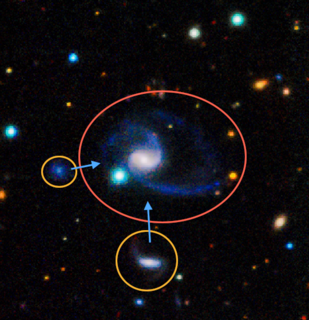
GAMA202627 is a barred spiral galaxy similar to our own Milky Way.
The following outline is provided as an overview of and topical guide to galaxies:
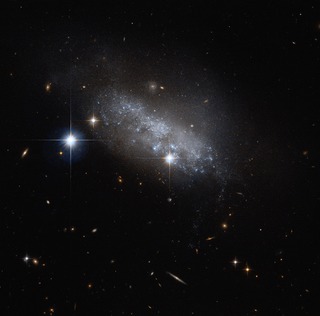
IC 3583 is an irregular galaxy some 30 million light-years away in the constellation of Virgo. It was discovered by Isaac Roberts on April 29, 1892.
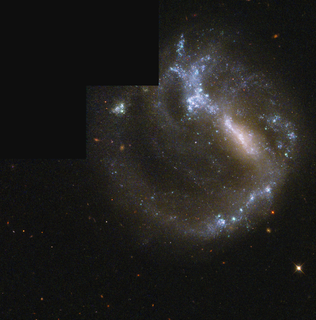
NGC 3664 is a magellanic barred spiral galaxy in the constellation of Leo. It is located about 80 million light years away from Earth, which means, given its apparent dimensions, that NGC 3664 is approximately 50,000 light years across. It was discovered by Wilhelm Tempel on March 14, 1879. The galaxy is characterised by its asymmetric shape, which features a single spiral arm and an off-centre bar. The distribution of HI is equally asymmetric.
References
- ↑ Sidney van den Bergh (1999). "The Local Group of Galaxies". arXiv: astro-ph/9908050 .
- ↑ Norbert Przybilla, Quantitative Spectroscopy of Supergiants, Munich, 2002
| This galaxy-related article is a stub. You can help Wikipedia by expanding it. |